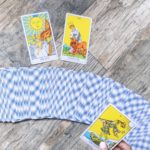Grief in Times of Uncertainty
It is now July 2020. Everything is still uncertain. I am trying to adapt, but I am burning out at the same time. Today I hope to shed some light on an experience that is common to us all, especially during this pandemic. The experience of ambiguous loss is common but not well-known or understood. As a grief and loss specialist, I not only work with losses due to death, I also work with the grief that comes from a job loss, relationship loss, and ambiguous loss. Although this piece I’m writing is not an extensive or in-depth description of ambiguous loss, I hope to help some of you put a name to what you might be experiencing.
What is an ambiguous loss?
Ambiguous loss is a loss that is unclear because there is uncertainty about the presence and absence of the person, place, or thing being lost. Ambiguous loss of a loved one can sound something like this: “it’s like they’re there, but they’re not there.” Ambiguous loss includes physical and psychological presence or absence. The term ambiguous loss was coined by Dr. Pauline Boss in the 1970s. In her book, Loss, Trauma, and Resilience: Therapeutic Work with Ambiguous Loss, she divides ambiguous loss into two types: someone can be physically present but psychologically absent (e.g, dementia, depression, obsession with electronic devices, etc). On the other hand, someone can be physically absent and psychologically present (i.e., in our mind and hearts) such as when we experience break-ups, separations, or a missing person’s case. In both cases, the ambiguous loss is painful because of the lack of clarity. The biggest difference between ambiguous loss and losing someone to death is that when we lose someone to death we have the opportunity to process grief. In the case of ambiguous loss, the uncertainty of the loss hinders our ability to cope and grieve, leading us to feel stuck. Dr. Boss says it best when she says, “ambiguous loss leads to frozen grief.” One thing to note about ambiguous loss is that it can be experienced with a person, place, or thing. As long as you had a connection to the person, place, or thing you can experience a sense of loss. This brings me to how ambiguous loss impacts us today.
How does ambiguity impact us?

Most people have a hard time being in a situation that is not in their control (including myself). If we add a pandemic and lockdowns this becomes more than a “hard time.” Right now we are in a state of “prolonged uncertainty”, as Esther Perel calls it. This prolonged uncertainty is not just marked by the feeling of uncertainty about the pandemic but also the uncertainty about how long we will have to endure this uncertainty. This is what causes ambiguous loss.
What we once knew is still out there but, for the most part, it is out of our reach. We still don’t know how long this will last. We not only lost a sense of normalcy, but we also don’t know what normal will look like in the future. Our roles have changed and our relationships are different. The way we connect is mostly virtual; we are there, but we’re not there. Everything is still uncertain and it is taking a toll on us physically, mentally, and spiritually. The ambiguous loss caused by lockdowns and social distancing has created a sense of isolation and disconnection.
Ambiguity also leads to ambivalence. Ambivalence is the experience of having conflicting feelings and emotions. In other words, more uncertainty about how we feel. Ambiguity leads to ambivalence because our loss is not definite, so we don’t have the opportunity to grieve or process our loss. You may have noticed that sometimes you feel fine or like you’re doing a good job “adapting” to the situation, and other days you may feel fed up, frustrated, or defeated. This switching back and forth between the highs and the lows is normal when we experience ambiguous loss. However, ambiguity feeds ambivalence and leads to anxiety. If ambiguity feeds ambivalence then ambivalence feeds our uncertainty leading us to feel helpless and at times paralyzed or numb. That paralysis or numbness is considered frozen grief.
Uncertainty on top of uncertainty. What can we do about it?
Helpful Tips to Cope
Although ambiguous loss can be one of the most difficult experiences to cope with, because the uncertainty may never end in certain situations, there are ways to cope with the ambivalence. Dr. Pauline Boss writes about how therapists can help people cope with ambiguous loss by normalizing ambivalence. Normalizing ambivalence is key to coping with ambiguous loss. The following list is a starting point to cope with ambiguous loss and ambivalence, but before you start there remember that it is important to have a place to talk about your losses with people who understand.
According to Dr. Boss, the first step in normalizing ambivalence is to name it and externalize it. I’ve created a list of how you can continue to normalize ambivalence and ambiguous loss:
- Give the problem a name: when we acknowledge what we’re feeling we take power away from the thing that seems to be controlling us. In this case, it can be an ambiguous loss, ambivalence, fear, or even relief. Name it first.
- Externalize the cause: in other words, remember that what you are feeling is caused by something outside of your control. The pandemic, lockdowns, and social distancing are causing the ambivalence and ambiguous loss, not your ability to cope.
- Normalize the difficult feelings, bring the ambivalent feelings into the open. The only way to normalize something is if we talk about it.
- Once you are aware of your ambivalent feelings you give yourself a better chance to manage them.
- Finally, ask questions about the context and situation you are experiencing. It’s very common to take our thoughts and feelings out of context and blame ourselves for “not being able to cope.” We are experiencing an abnormal situation, of course, you are going to have abnormal responses, that is normal.
Sonia Fregoso is a Licensed Marriage and Family Therapist (LMFT #104403). She earned her Masters degree in Marriage and Family Therapy from the University of Southern California (USC) and her Bachelors degree in Psychology from the California State University of Los Angeles (CSULA).
Sonia was born and raised in the Los Angeles community of Boyle Heights. Sonia is passionate about serving her community, creating spaces for healing, and spreading the word about holistic approaches to healing. Her approach to helping others is rooted in her learnings of being human first, therapist second. She is known for her openness, calmness, and humor as she helps clients share their story arming them with tools to encourage the self-healing process that can lead them to find and feel relief. She utilizes her education, personal experience, and intuition to guide her holistic approach that honors the relationship between mind, body, and spirit. She also uses a combination of Cognitive Behavioral Therapy (CBT), Narrative Therapy as well as intuitive, holistic healing approaches.
-
Sonia Fregoso, LMFThttps://psychosocial.media/author/sonia/August 4, 2019
-
Sonia Fregoso, LMFThttps://psychosocial.media/author/sonia/September 1, 2019
-
Sonia Fregoso, LMFThttps://psychosocial.media/author/sonia/July 18, 2021























